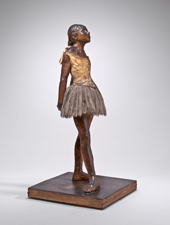Little Dancer Aged Fourteen
Technical Notes: Internal Construction
Technical Notes: Exterior Construction
Study in the Nude of Little Dancer Aged Fourteen (Nude Little Dancer)
Fourth Position Front, on the Left Leg
Formal Analysis
In calling the figure a “statuette” in the 1880 and 1881 exhibition catalogues, Degas insists on the artfulness of this unusually lifelike sculpture. Otherwise, the figure resides in a fluidly ambiguous zone, emitting inconsistent signals and shifting among forms of illusionism and artistry.[1] Beyond her puzzling combination of work and performance attire, the figure posits a series of paradoxes. However mottled, darkened, and opacified with time, the wax of her skin is still subtly translucent and soft, as in life.[2] Realism is layered: she wears a “real” tutu and hair ribbon, but her buttoned cloth bodice, hair, and beribboned slippers are covered with wax and her stockinged legs are purely modeled wax. The top layer may integrate the whole, as Sturman and Barbour argue in the Technical Notes above, along with other scholars,[3] but it also establishes ambiguities that only grow with scrutiny. The intermittent wax coat is so dominant that it suggests a human partially embedded in amber. The entire enterprise comes into question with the effect of the head, which seems to metamorphose. Her face is modeled wax; her bangs and hair to the nape of her neck, wax — deemed, on the basis of testing, to be original[4] — with lighter-colored “real” hair strands projecting through until they emerge, loosely braided, in thick profusion beyond the ribbon in back.
Facture simultaneously lends to the figure’s overall effect and calls attention to itself: de Mont even complains that, for all its realism, Little Dancer is barely a maquette.[5] Degas’s surface handling varies throughout. The heated spatula left textured ridges; the calves bear light tooling that graduates to heavy on the upper thighs, with delicate lines around the knees that add fine incised wrinkles to the modeled ones. The arms are more loosely modeled than other parts of the body, leaving an especially rumpled surface over the lithe muscles, and the right arm is extensively tooled. The fingers of the hands, as Sturman and Barbour in the Technical Notes above indicate, are fully distinguished and detailed, except for the schematic handling of the palms with their rope “armature.” The head, however, is especially dramatic, with its top layer apparently worked with a heated spatula and lightly tooled, leaving a delicately vibrant and textured surface that declares its direct handling; all features, including the ears, are finished with extraordinary sensitivity, rendering them as softly translucent as “real” tissue. That delicate detail contrasts with the broadly modeled and heavily tooled wax of the hair around it.
Degas’s handling of Little Dancer calls for a great deal from the viewer. Avoiding clear legibility at so many turns, this figure’s subtle juxtapositions throw us off balance even more, demanding fresh, intense looking and thinking, a compellingly dynamic process of our own.
Notes
1. Wolfgang Drost, "Colour, Sculpture, Mimesis: A Nineteenth-Century Debate," in Andreas Blühm et al., the Colour of Sculpture, 1840–1910, exh. cat. (Amsterdam, 1996), 70, establishes one dimension of this dynamic as a “tension between the objective reality of clothing and hair . . . and the artistic facture in the formation of the body.”
2. Richard Kendall, Degas and the Little Dancer, exh. cat. (New Haven and London, 1998), 74, instead points to the lack of realism of the figure’s dark wax “skin,” associating her more with ancient bronzes in museums than with the typical Opéra dancer.
3. Charles W. Millard, The Sculpture of Edgar Degas (Princeton, 1976), 38 – 39; Kendall, Degas and the Little Dancer, 41.
4. Suzanne Quillen Lomax, Analysis Report, January 4, 2004, NGA conservation files, and Michael Palmer, Analysis Report, March 29, April 17, 2002, NGA conservation files, GC-MS, SEM-EDS, and PLM analysis. Their findings argue against the widespread conclusion that this wax was added when the figure was cast in bronze (e.g., posthumously), a view suggested by Theodore Reff, Degas: The Artist's Mind (New York, 1976), 248.
5. Élie de Mont, "L'Exposition du boulevard des Capucines," La Civilisation, April 21, 1881.
